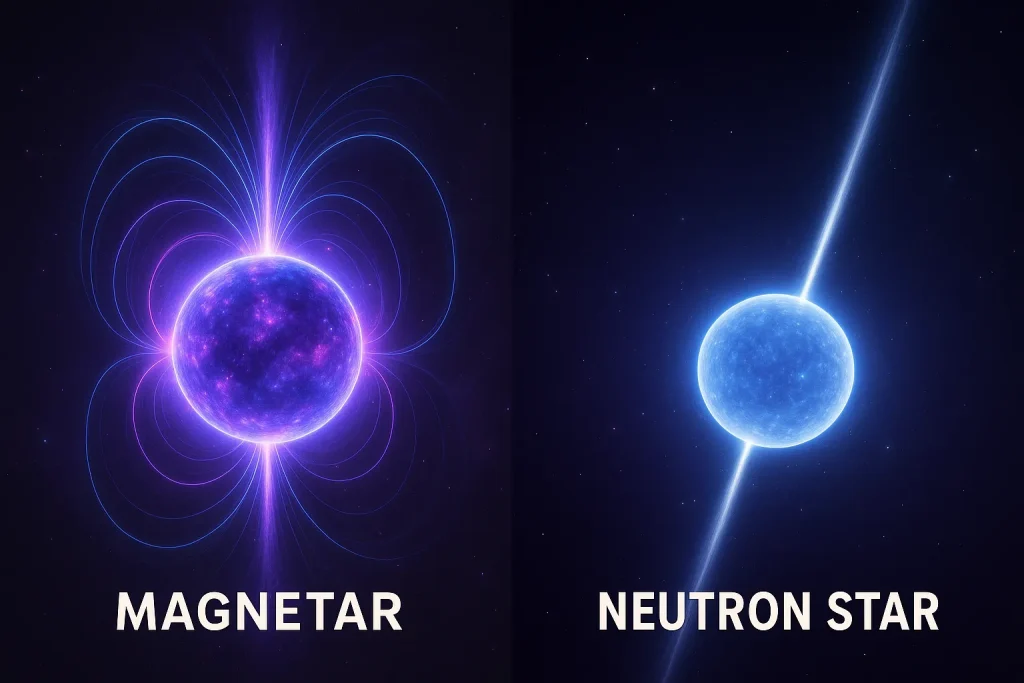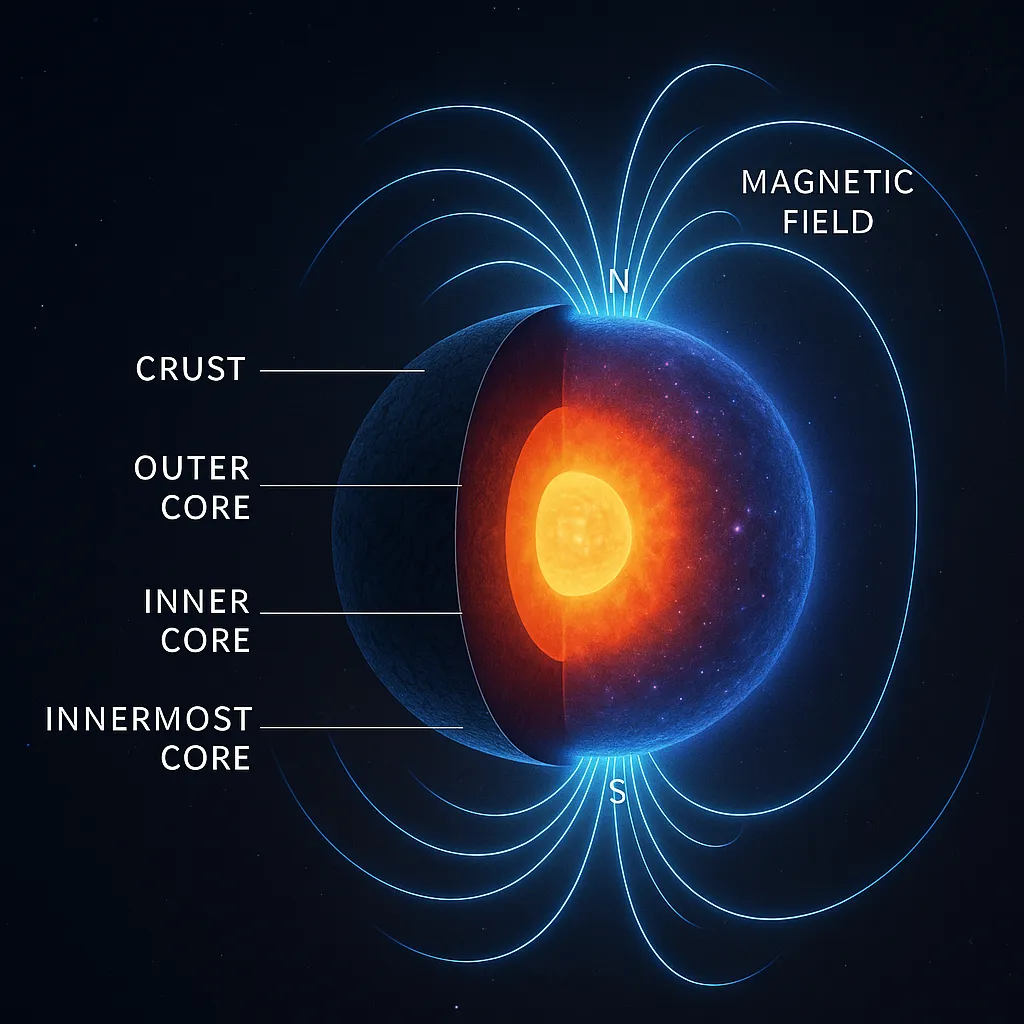Introduction
Magnetars in the universe captivate scientists with their extreme magnetic fields. These neutron stars form from massive stars collapsing in supernova explosions and boast fields trillions of times stronger than Earth’s, hitting 10^15 gauss. Their power turns them into unique labs for extreme physics, far beyond Earth’s capabilities. A magnetar’s field warps atoms, triggers energy bursts, and shapes cosmic events across vast distances. For example, its strength could erase credit card data from 100,000 miles away. This article examines their formation, traits, and cosmic role.
Astronomers first spotted magnetars in the universe in 1979 via Soviet probes Venera 11 and 12. These probes detected a gamma-ray burst, later identified as SGR 0525−66 in the Large Magellanic Cloud, 163,000 light-years away. Magnetars spin slower than typical neutron stars—every 2 to 10 seconds—and emit X-rays and gamma rays due to intense magnetic activity. Their link to fast radio bursts (FRBs) fuels modern astrophysics research. Moreover, their study opens new doors to cosmic mysteries.
Despite this, studying magnetars poses challenges. Only about 30 are confirmed as of 2021, with a few candidates, limiting observations. Their extreme nature and short active lifespan of a few thousand years complicate research. Telescopes like the Very Large Telescope and NICER now provide fresh insights despite these hurdles. This drives scientists to explore their cosmic impact further.

Formation and Magnetic Fields
Massive stars, 10 to 25 times the Sun’s mass, collapse in supernovas to create magnetars in the universe. This collapse shrinks the core into a neutron star, just 20 kilometers wide, with density so high that a tablespoon weighs over 100 million tons. Rapid rotation and convection in the dense fluid trigger a magnetohydrodynamic dynamo, converting rotational energy into a magnetic field. For example, halving the star’s size boosts its field strength fourfold to 10^11 teslas. The Tayler-Spruit effect drives this process.
Magnetars in the universe develop complex magnetic fields with poloidal and toroidal components. A progenitor star’s strong field may amplify during collapse, or fallback material from the supernova may speed up rotation to start the dynamo. The interior, with superfluid neutrons and exotic states, acts like a superconducting fluid, sustaining the field. However, a too-fast initial spin can shut down the dynamo, preventing magnetar formation.
Interestingly, magnetic fields decay over time, powering emissions and causing crust cracks. These starquakes release energy bursts, linking magnetars to other neutron stars like pulsars. Some suggest stellar mergers in binary systems aid the magnetar formation process, though field amplification details remain debated. In contrast, this decay shapes their evolution. Thus, their formation reveals extreme physics.

Types and Observations
Magnetars in the universe fall into two main types: Soft Gamma Repeaters (SGRs) and Anomalous X-ray Pulsars (AXPs). SGRs emit powerful gamma-ray bursts, like the 2004 flare from SGR 1806−20, which hit 10^47 erg/s and affected Earth’s magnetic field from 50,000 light-years away. AXPs release steady X-rays with occasional bursts, driven by magnetic decay. PSR J1745−2900 near Sagittarius A*’s black hole, found in 2013, shows their extreme settings.
Modern tools enhance magnetar observations. In 2008, ESO’s Very Large Telescope spotted SWIFT J195509+261406, the first optically active candidate. XTE J1810-197 “woke up” in 2018 with wobbly radio signals, puzzling scientists. The Neutron Star Interior Composition Explorer (NICER), launched in 2017, delivers detailed data on their structure. Nevertheless, these findings challenge standard models, especially the unexplained wobbles.
In contrast, their transient nature complicates study. Outbursts reveal them, but their short active life limits data. Some bursts mimic gamma-ray bursts, causing confusion. Facilities like ASKAP linked SGR 1935+2154 to FRBs in 2020, advancing research. Moreover, more observations are needed to clarify their behavior.

Energy Emissions
Magnetars in the universe emit intense energy, mainly X-rays and gamma rays, from magnetic field decay. These include short bursts, outbursts, and rare giant flares, often with timing oscillations. The 2004 flare from SGR 1806−20 matched 100 times the Sun’s output in a second, visible galaxy-wide. Starquakes, triggered by magnetic stress, release this energy as X-ray flares seen billions of light-years away.
Magnetar energy bursts vary widely. Short bursts last milliseconds, while giant flares, like those in 2004, feature a decaying tail. In 2020, SGR 1935+2154 tied magnetars to fast radio bursts (FRBs), possibly from magnetospheric conditions. Surface heating from magnetic decay produces steady X-rays, offering clues to field physics. Interestingly, these emissions highlight their luminosity.
Despite this, some emissions baffle scientists. XTE J1810-197’s 2018 wobbly signals defy models, suggesting unknown processes. Misclassification with extragalactic events occurs. Telescopes since the 1980s, like those catching SGR 0525−66’s 1979 burst, improve detection. On the other hand, this progress refines our view of their energy.

Role in Cosmic Events
Magnetars in the universe influence cosmic events, including fast radio bursts and heavy element formation. The 2020 link between SGR 1935+2154 and FRBs suggests magnetars trigger these signals via magnetospheric flares. A 2024 study proposes giant flares forge gold, ejecting it into space during starquakes, impacting early element distribution. This challenges traditional formation theories.
Magnetars also tie to gamma-ray bursts and supernovae. Some suggest their giant flares mimic short GRBs, though evidence lacks. In 2018, a neutron star merger formed a hypermassive magnetar that collapsed into a black hole, observed multi-wavelength. Their fields affect the interstellar medium, as seen with PSR J1745−2900. Moreover, these interactions shape stellar evolution.
Nevertheless, their role faces scrutiny. No FRBs followed thousands of short bursts by 2019, weakening the link. Some doubt their rarity fits all FRBs. The 2025 LSU study on gold formation boosts their cosmic role. In contrast, more data is needed. Thus, they shape our cosmic understanding.

Leave a Reply